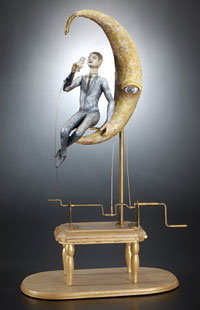Automata: Contemporary Mechanical Sculpture
 Neil Hardy, The Early Bird, 2004, wood, brass, paint, 9 x 9 x 5 in. Croft Collection
Neil Hardy, The Early Bird, 2004, wood, brass, paint, 9 x 9 x 5 in. Croft CollectionPhotograph courtesy of Chazen Museum of Art
Traditionally, the term "automaton" referred to a mechanized device constructed to perform actions as if by its own motive power. Like robots, animatronics, and clockwork figures, early automata were engineered to imitate life; thus, their inner workings were hidden from view. Notable examples of self-moving naturalistic sculptures include jointed religious effigies of ancient Egypt, pneumatic models of ancient Greece, a mechanical orchestra created for the emperor during China's Han Dynasty, and monumental animated water clocks of the medieval Islamic world.
 Dean Lucker, Man Drinking in the Moon, 2009, wood, metal, paint, 13 x 7 x 4 in.
Dean Lucker, Man Drinking in the Moon, 2009, wood, metal, paint, 13 x 7 x 4 in.Photograph courtesy of Chazen Museum of Art
Some of the best-known automata were designed by French engineer Jacques de Vaucanson in the eighteenth century. His life-sized mechanical duck, made of gilt brass, used flexible rubber tubing for intestines and more than 400 moving parts in one wing alone. It looked like a duck, moved like a duck, quacked like a duck - and on being fed corn it even defecated like a duck. Vaucanson's work ushered in a nineteenth-century golden age of animated clockwork clowns, acrobats, and entertainers, which were popular as parlor amusements and department store window displays until World War I.
Today's artist-designed automata tend toward imaginative storytelling, suspending reality and exploring playful worlds beyond everyday existence. Many sculptors are drawn to automata for the expressive possibilities of working with wood, metal, and wire in motion. They also incorporate the element of time, using the wind-up and release of mechanical tension to parallel the build-up and punch line of a tale. Many artists appreciate the mass appeal of mechanical sculpture and find great satisfaction in seeing how audiences experience the work.
Resources:
Also in this Issue:
- Kinetic Art: Copper in Motion
- Anita DiPietro Designs
- Luster Metal Works: Transforming Metal
- Speaking Through Copper
- Automata: Contemporary Mechanical Sculpture
